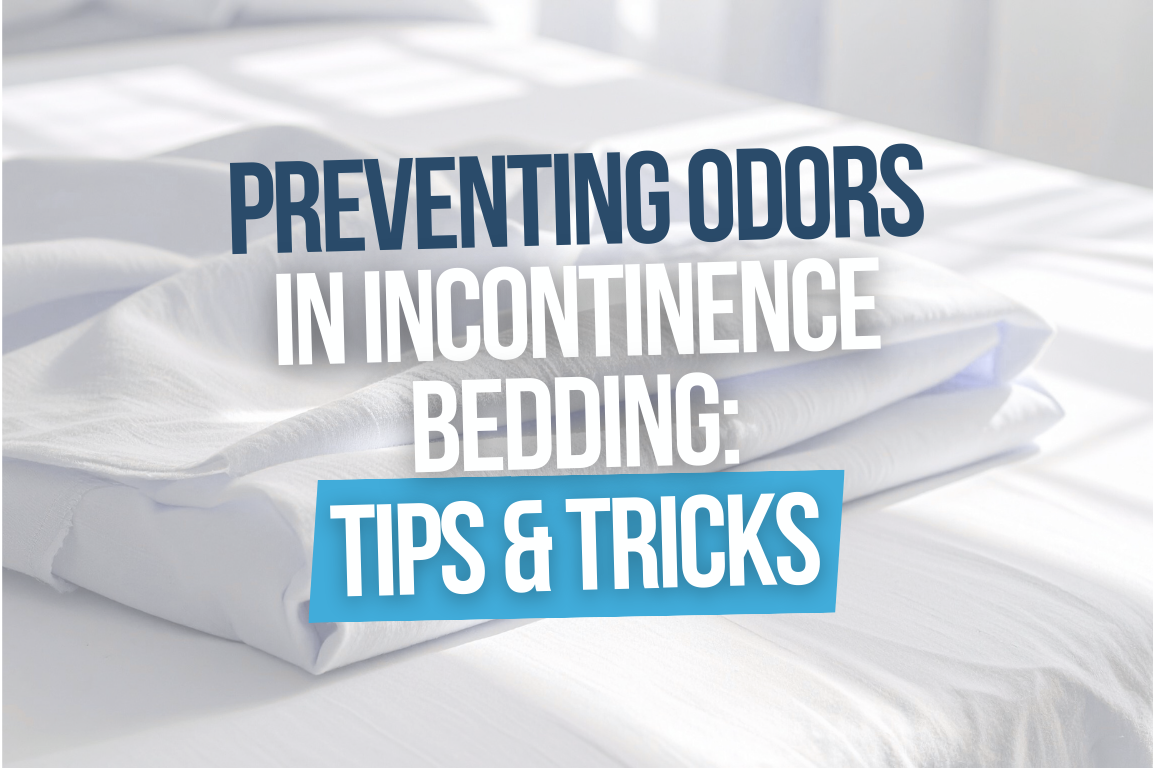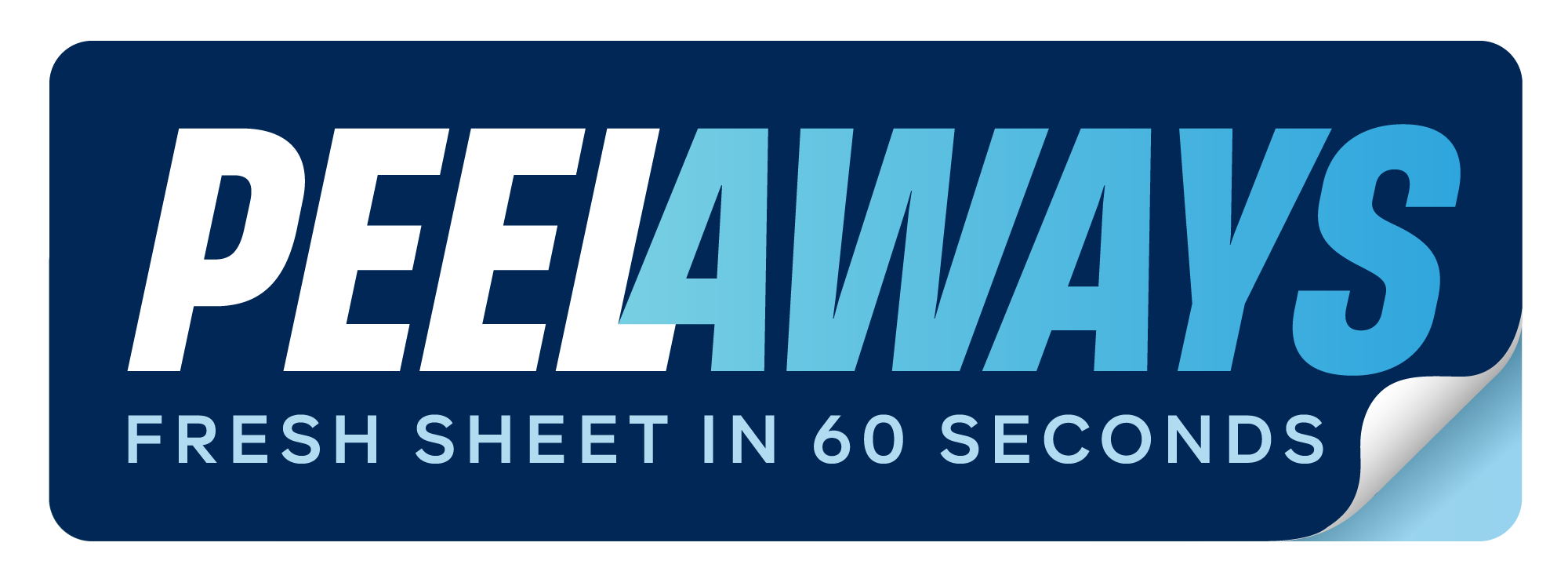Preventing Odors in Incontinence Bedding: Tips and Tricks

Dealing with odors in incontinence bedding can feel overwhelming, but it doesn’t have to be. The key is addressing moisture, bacteria, and cleaning routines effectively. Odors stem from urine breakdown, bacterial activity, and delayed cleaning, but with the right strategies, you can maintain a clean, comfortable, and odor-free sleeping environment.
Here’s how you can prevent odors:
- Layer smartly: Use multi-layer waterproof bedding like PeelAways, which lets you peel off soiled layers without stripping the entire bed. This minimizes exposure to bacteria and odors.
- Clean promptly: Remove soiled bedding within 15 minutes, rinse with cold water, and use odor-fighting products like white vinegar or enzymatic cleaners.
- Dry thoroughly: Ensure bedding is completely dry to avoid mildew and musty smells. Use high heat and breathable storage solutions.
- Practice hygiene: Regular handwashing, quick disposal of soiled items, and cleaning nearby surfaces keep odors in check and prevent cross-contamination.
Modern products like PeelAways disposable sheets simplify care, offering 5–7 layers of waterproof, breathable protection. Priced between $30.99 and $53.99, these sheets reduce laundry needs while controlling odors effectively. By following these steps, you can ensure a clean, dignified, and odor-free environment for yourself or those you care for.
What Causes Odors in Incontinence Bedding
Getting to the bottom of what causes odors in incontinence bedding is key to tackling the issue effectively. These unpleasant smells result from specific chemical and biological processes, but with the right steps, they can be minimized or even avoided.
Urine Chemistry and Bacterial Activity
Urine itself plays a big role in creating strong odors. Ammonia, a compound naturally found in urine, is responsible for its sharp, pungent smell. Over time, this odor becomes even more intense. When urine comes into contact with bedding, bacteria start breaking down the organic compounds in moist conditions, which amplifies the ammonia smell [1].
Moisture makes things worse, as it creates the perfect environment for bacteria to thrive and for odors to linger.
Moisture and Delayed Cleaning
When it comes to odor control, timing is everything. The longer urine is left on bedding, the harder it becomes to eliminate the smell. As Tru Earth US puts it:
"The longer urine sits on your sheets and mattress, the harder it becomes to remove the odor." [1]
The type of material also plays a role in how stubborn odors can be. Synthetic fibers, for example, tend to trap odor-causing compounds more than natural materials, making them particularly tough to clean once the smell sets in [2]. Adding to the problem, high humidity and poor ventilation can increase moisture levels, which further boosts bacterial activity [1][2]. What starts as a manageable issue can quickly escalate if not addressed promptly.
How to Use and Layer Bedding for Odor Prevention
Keeping your bedding fresh and odor-free comes down to smart layering. By creating multiple barriers against moisture and bacteria, you can maintain a clean and comfortable sleeping environment.
Multi-Layer Waterproof Bedding: A Game-Changer
When it comes to odor prevention, multi-layer waterproof bedding offers a practical solution. Unlike traditional waterproof covers that just block moisture, these systems provide added convenience. They allow you to remove a soiled layer, revealing a clean, ready-to-use surface underneath.
Take PeelAways disposable sheets, for example. These sheets feature a patented multi-layer design, offering 5 to 7 soft, absorbent layers. When an accident occurs, you simply peel off the top layer to expose a fresh one below - no need to lift the mattress or rush to do laundry. This design not only saves time but also minimizes exposure to bacteria and odors.
The breathable fabric used in these sheets helps reduce moisture buildup, which can otherwise lead to bacterial growth and lingering smells. This makes multi-layer bedding an excellent foundation for effective layering techniques.
Step-by-Step Guide to Layering Bedding
Start with a fitted waterproof mattress protector as your base. This acts as the first line of defense against moisture.
Next, add snugly fitting multi-layer disposable sheets. These should wrap tightly around the mattress corners to prevent shifting during the night. A proper fit is crucial - loose sheets can bunch up, creating gaps that allow moisture to reach the lower layers.
For areas prone to accidents, such as the hip and torso regions, you can place absorbent pads underneath. However, with high-quality multi-layer sheets like PeelAways, extra padding is often unnecessary, as their built-in absorbency handles most situations effectively.
The beauty of this setup is how quickly you can respond to accidents. Instead of struggling with wet sheets or risking mattress contamination, you can simply peel away the soiled layer in seconds, keeping odors at bay and your bed fresh.
Finding the Right Fit and Absorbency
Choosing the correct size and layer count is key to preventing leaks. PeelAways offers options with 5 to 7 layers in various sizes to ensure proper coverage and quick response to accidents.
Size matters more than you might think. A Queen-sized sheet on a King mattress, for instance, leaves the edges exposed, increasing the risk of leaks. On the other hand, oversized sheets can bunch up, making the bed uncomfortable and potentially increasing the chance of accidents.
When it comes to absorbency, consider your specific needs. For healthcare settings or severe incontinence, higher layer counts are ideal. A Twin XL sheet with 7 layers, for example, works well for hospital beds or long-term care environments. For occasional use, fewer layers might suffice.
Finally, the breathable fabric in these sheets ensures comfort without the sweaty, plastic-like feel of traditional waterproof covers. This balance helps reduce moisture buildup, further preventing odor issues while keeping the bed comfortable for a good night’s sleep.
Cleaning and Maintenance Tips to Control Odors
Keeping odors at bay in your bedding starts with prompt and effective cleaning. By tackling stains and spills immediately, you can stop bacteria from multiplying and causing unpleasant smells.
Quick Cleaning of Soiled Bedding
Act fast when bedding gets soiled to prevent odors from setting in. Moisture left on fabric gives bacteria the perfect environment to grow, leading to lingering smells.
For multi-layer disposable sheets, peel off the top soiled layer as soon as possible. With traditional bedding, try to remove stained items within 15 minutes. The longer you wait, the deeper the moisture seeps into the fibers, making it harder to clean. Strip the bed completely, including any waterproof covers that might have been compromised.
Rinse soiled items in cold water to flush out contaminants. Avoid hot water, as it can lock in protein-based stains and odors, like those from urine. Always wear disposable gloves to prevent cross-contamination, and place the soiled bedding directly into the washing machine or a sealed laundry bag to contain odors during transport.
Once rinsed, it’s time to use the right cleaning agents to neutralize any remaining smells.
Using Odor-Fighting Cleaning Products
Certain cleaning products are especially effective at tackling odors caused by incontinence:
- White vinegar: Add a cup of white vinegar to your wash cycle. Its acetic acid neutralizes the ammonia in urine, which is often the source of persistent smells.
- Enzymatic cleaners: These are great for breaking down the proteins and bacteria responsible for odors. Look for products made for pet accidents or medical use, as they’re formulated to handle urine-based stains and smells.
- Baking soda: Use a quarter cup of baking soda along with your regular detergent. It naturally absorbs and neutralizes odors.
Avoid fabric softeners and heavily scented detergents, as they can coat fabric fibers and trap odors, making future cleaning less effective.
For tougher odors, consider a two-step washing process. Start with a cold water cycle using an enzymatic cleaner, then follow with a warm water cycle using regular detergent and white vinegar. This method tackles both fresh and set-in smells.
If you’re working with white bedding, oxygen bleach can be helpful. It’s gentler than chlorine bleach but still effective at breaking down odor-causing compounds. Always test it on a small area first to ensure it’s safe for your fabric.
After cleaning, proper drying is essential to prevent any odors from coming back.
Complete Drying and Storage
Drying bedding thoroughly is critical to avoid mildew and musty smells, especially in humid conditions. Even slightly damp fabric can develop unpleasant odors within hours.
Use the hottest dryer setting that’s safe for your bedding material. High heat not only dries the fabric but also kills any remaining bacteria. Toss in a few tennis balls to improve air circulation and ensure more even drying.
Pay extra attention to thick seams and elastic edges - they can trap moisture. If you’re unsure whether the bedding is completely dry, run it through another 10-15 minutes on high heat.
When storing clean bedding, choose a dry, well-ventilated area. Avoid plastic bags or airtight containers, as they can trap residual moisture and encourage mold growth. Instead, opt for breathable cotton storage bags or simply fold the bedding neatly in a well-ventilated linen closet.
For disposable products like PeelAways, keep them in their original packaging in a cool, dry spot. Avoid storing them in bathrooms or other humid areas where moisture could compromise their waterproof layers. Adding moisture-absorbing packets to storage areas, especially during humid months, can also help maintain optimal conditions and prevent dampness from causing odor problems later on.
sbb-itb-45288fe
Hygiene and Cross-Contamination Prevention
Effective odor management goes hand in hand with strong hygiene and handling practices. Maintaining cleanliness not only keeps odors in check but also protects everyone involved in incontinence care. When bacteria and contaminants spread from person to person or surface to surface, they create more opportunities for unpleasant smells to develop and linger.
Maintaining Personal Hygiene
Daily personal hygiene is the cornerstone of odor prevention. Regular washing helps minimize bacterial buildup and reduces odor risks.
Encourage daily bathing or showering with warm water and a gentle, pH-balanced soap. Pay extra attention to areas prone to moisture, as these spots tend to harbor odor-causing bacteria. After any incontinence episode, clean the skin promptly using unscented, alcohol-free wipes or a damp washcloth with mild soap.
Hand hygiene is vital. Always wash hands thoroughly for at least 20 seconds with soap and warm water before and after handling bedding, assisting with personal care, or touching potentially contaminated surfaces. If soap and water aren’t available, use an alcohol-based hand sanitizer containing at least 60% alcohol.
For caregivers, keeping a small bottle of hand sanitizer nearby during tasks like bedding changes makes it easier to maintain clean hands between steps. For instance, you’ll want clean hands after removing soiled sheets and before applying fresh ones.
Switch to clean clothing immediately after any contamination to further reduce the risk of spreading bacteria.
Safe Storage and Disposal of Soiled Products
Proper handling of soiled bedding is critical for controlling odors and preventing contamination from spreading to clean areas. Quick containment is key to minimizing bacterial growth and unpleasant smells.
Seal soiled bedding in airtight, double-bagged plastic bags right away to prevent leaks and odors. Store these sealed bags in a designated area, away from living spaces, and aim to wash the items within 24 hours.
For disposable bedding products like PeelAways, the process is even easier and more hygienic. Simply peel away the soiled layer and dispose of it immediately in a sealed bag. This design eliminates the need to handle wet or contaminated bedding directly, reducing exposure to bacteria and odor-causing compounds.
Tie plastic bags securely and dispose of them promptly in household trash. Avoid leaving soiled items in open containers or unsealed bags, as this allows odors to escape and bacteria to multiply. During warmer months, consider storing sealed bags in a cool area or disposing of them more frequently to prevent faster bacterial growth.
Keep disposable gloves near bedding storage areas, and always wear gloves when handling soiled materials. Dispose of gloves immediately after use, and never reuse them between tasks, as this can spread bacteria to clean surfaces.
Regular Cleaning of Surrounding Surfaces
Keeping the surrounding environment clean is just as important as personal hygiene and proper disposal. Routine cleaning of nearby surfaces helps prevent odors from settling in.
Disinfect bed frames, nightstands, and other nearby furniture weekly. Pay attention to surfaces frequently touched during bedding changes. Wooden furniture can absorb odors over time, so use appropriate wood cleaners to neutralize any trapped smells.
Floors around the bed need daily cleaning, especially if moisture has reached them during bedding changes. Mop hard floors with a disinfectant cleaner, and vacuum carpets thoroughly. For carpets exposed to moisture, enzymatic cleaners designed for pet accidents are highly effective, as they break down similar compounds found in human urine.
Clean high-touch surfaces and upholstered items daily with suitable disinfectants. Wash or replace fabric items in the room - like curtains or decorative pillows - every few weeks to prevent them from absorbing odors.
Improve air circulation by opening windows when possible or using fans to keep the air moving. Stagnant air allows odors to settle into fabrics and surfaces. Placing moisture-absorbing products like activated charcoal or baking soda in discreet areas can help manage humidity and neutralize lingering smells.
Keep cleaning supplies handy in or near the bedroom. Having disinfectant wipes, spray cleaners, and paper towels within reach encourages quick action on spills and contamination, stopping potential odor issues before they escalate.
Odor Prevention Features in Modern Bedding Products
Modern bedding products have stepped up their game, tackling odor issues at the source while making care easier and improving hygiene. These features work hand in hand with the cleaning and maintenance tips mentioned earlier.
Benefits of Multi-Layer Disposable Sheets
PeelAways' patented multi-layer disposable sheets (offering 5–7 layers) are a game-changer for caregivers. Instead of dealing with the hassle of stripping an entire bed and handling wet linens, you can simply peel away the top layer of the sheet in less than a minute[3][4]. This quick removal helps prevent leaks and bacterial growth, making it an efficient and hygienic option.
This approach not only saves time and effort but also ensures a discreet, dignified experience for individuals managing incontinence. Plus, these sheets are designed with comfort in mind - they’re 32% softer than traditional bedsheets[4], offering a balance of practicality and coziness.
Key Product Features for Odor Control
PeelAways sheets go beyond convenience with features that actively combat odor. Made from 100% waterproof, chemical-free materials, they block liquid penetration, which helps curb bacterial growth and reduces the risk of skin irritation. Importantly, they’re free from vinyl, PVC, phthalates, and fire retardants, ensuring a safer, more skin-friendly option.
The breathable top layers promote air circulation, reducing moisture buildup while maintaining the waterproof barrier. This design not only enhances hygiene but also helps caregivers save money by cutting down on water, electricity, and detergent costs - since only the soiled layer needs to be discarded.
These products have clearly struck a chord with users. PeelAways has racked up over 6,000 five-star reviews with an impressive average rating of 4.8 out of 5 stars[3]. On Amazon, they maintain a solid 4.2-star rating from 1,835 global reviews, reflecting their consistent performance in odor control and user satisfaction.
Available Sizes and Applications
PeelAways offers a variety of sizes to meet the needs of different care settings. For pediatric care, the Crib-A-Peel provides 5 layers of protection, ideal for babies and toddlers, especially during potty training.
In healthcare facilities and home care environments, the Cot and Twin XL options - with up to 7 layers of protection - are perfect for hospital beds, assisted living facilities, and recovery situations that require frequent bedding changes. For standard home use, sizes include Twin, Full, Queen, and King, each featuring 5 layers of protection. Families can also purchase gift cards, making it easier to support loved ones in need.
For organizations managing multiple beds, case quantities are available, providing a cost-effective way to ensure consistent odor prevention across all care areas.
Key Takeaways for Odor Prevention
Preventing odors starts with tackling the root causes and implementing practical steps. For instance, removing soiled bedding promptly can stop bacteria from growing and producing unpleasant smells. Products like PeelAways make this easier with their multi-layer disposable sheets, which let you peel away a layer without needing a full bedding change.
Using waterproof and breathable materials is another smart move. These fabrics block moisture while allowing air to circulate, creating an environment less conducive to bacterial growth.
Opting for chemical-free bedding not only helps reduce skin irritation but also keeps odors in check, contributing to a healthier and more comfortable space.
To avoid cross-contamination, dispose of soiled materials properly, clean nearby surfaces thoroughly, and prioritize personal hygiene.
On top of health benefits, modern odor prevention methods can save money. Multi-layer disposable sheets cut down on water, electricity, and detergent costs compared to frequently laundering traditional bedding. For example, PeelAways sheets, priced between $30.99 and $53.99 for 5–7 layers, offer a budget-friendly solution by reducing the need for constant laundry.
Ultimately, effective odor prevention maintains a balance between hygiene, comfort, and dignity, ensuring a fresh and breathable sleeping environment.
FAQs
How does the unique multi-layer design of PeelAways sheets help reduce odors in incontinence bedding?
PeelAways sheets are designed with multiple layers to tackle odors by absorbing moisture and trapping soiled layers. When one layer gets dirty, you just peel it off to uncover a fresh, clean sheet below. This simple and sanitary process not only keeps odors at bay but also eliminates the hassle of washing and lowers the chance of cross-contamination. It's an easy way to ensure a cleaner, more comfortable sleeping experience.
How can I keep incontinence bedding fresh and odor-free?
To keep incontinence bedding clean and odor-free, it's crucial to replace bedding and incontinence products as soon as they become soiled. Washing bedding regularly with warm water and a mild detergent helps remove bacteria and lingering odors. For an extra touch of freshness, try sprinkling baking soda on dry bedding before tossing it in the wash - it’s a simple trick to neutralize unpleasant smells.
Quickly disposing of soiled items and maintaining a hygienic environment around the bedding area are equally important. If you’re after a more convenient solution, Peelaways disposable bed sheets might be just what you need. Their multi-layer design allows you to peel away a soiled layer to instantly reveal a clean one underneath, cutting down on laundry and making cleanup a breeze.
Why does selecting the right size and absorbency for incontinence bedding matter for odor control?
Choosing the right size and absorbency for incontinence bedding is key to maintaining both hygiene and odor control. Properly fitting bedding helps prevent leaks, while high absorbency ensures moisture stays contained, reducing the likelihood of unpleasant odors.
Selecting bedding that can handle the appropriate volume of moisture creates a cleaner, more comfortable environment and lowers the risk of cross-contamination. This is particularly crucial for individuals managing long-term incontinence care or recovery.
Related Blog Posts
- 7 Tips for Preventing Skin Irritation from Incontinence
- Why Organic Waterproof Bedding Matters for Incontinence Care
- How to Remove Odors from Incontinence Bedding
- How to Choose Bedding for Incontinence Care
Comments
0

SAVE MONEY & WATER
Professionals & Institutions save a fortune on labor/laundry.

SUPERIOR COMFORT
The first thing our customers notice is how soft our sheets are.

100% WATERPROOF
Each layer is 100% Waterproof, perfect for spills and accidents

SAVE TIME
Change the sheet in under 1 minute without stripping the bed.




Leave a comment